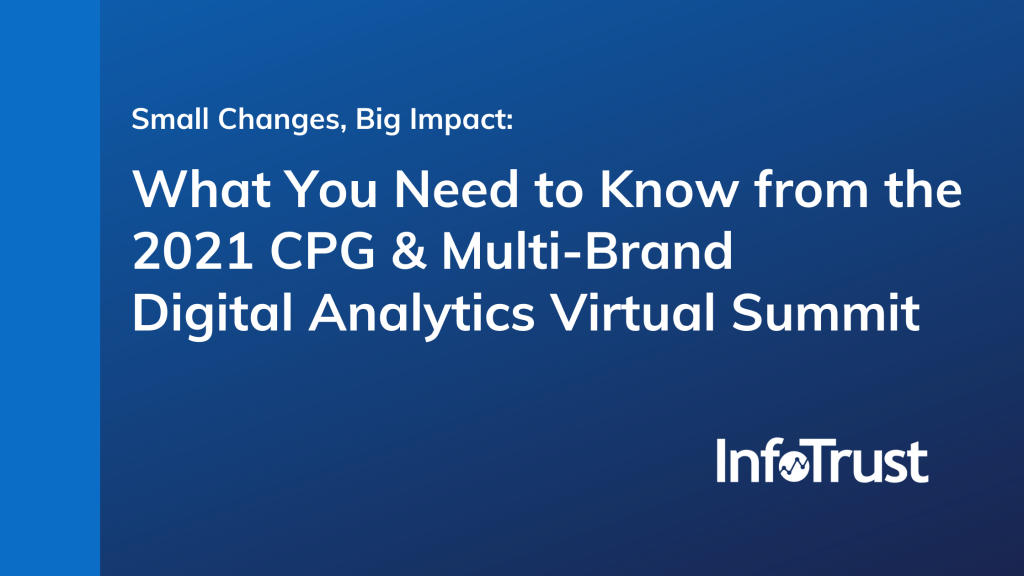Amidst the ever-changing marketing landscape, it is crucial to have a durable strategy and response. During our recent virtual summit, we focused on MarTech durability, Google Analytics 4 and how it affects CPG organizations, how data governance and consumer privacy laws will impact CPG digital marketing, and much more.
This summit brought together the brightest minds from the top CPG and FMCG organizations in the world. Presenters shared best practices and learnings on how to approach the marketing landscape with a durable approach and mindset.
Did you miss the event? No worries! We’ve got the top things to know from each presentation and a recording of the summit in its entirety. For now, let this inspire and motivate you as 2021 winds down and 2022 begins!
Google Keynote: State of CPG Digital
Joanna Goldblatt, Head of Data & Tech Sales: Consumer Goods, Government & Entertainment, Google
Michael Loban, Chief Growth Officer, InfoTrust
- Change unifies all of us—and the way we operate in the midst of a pandemic and digital marketing evolution is about adapting. The CPG industry is rapidly changing with consumer expectations. That means there’s not only an opportunity for marketers, but also a responsibility for us all.
- Change is impacting a myriad of things: eCommerce growth in 2020 was through the roof; the need and demand for personalized consumer experiences was heightened; transparency in all areas of business was imperative; and the data privacy framework was under a microscope.
- In order to move forward as an organization, you must be willing to fail—and then get back up. It takes a lot of time and a lot of small motions, but having an experimentation mindset means identifying a specific problem at your organization and “thinking like a scientist.” Approach a problem with a clear question and open mind, and then start to identify solutions that might answer or fix it. The result is thousands of small and not-so-small experiments that together will generate huge benefits—and hopefully be repeated!
- Is the consumer really at the center of your strategy? Are you thinking long-term or planning just for today? You have the responsibility to your organization and your consumer to be thinking about both.
How Current and Future Consumer Privacy Requirements are Shaking Up CPG Digital Marketing
Lucas Long, Privacy Specialist, Tag Inspector
Shaafi Khokhar, Global Director, Media Technology and Engagement, GSK
- Consumer expectations: People are becoming more aware/selective about what they are sharing on websites and mobile apps. You should focus on developing a personal connection with the user to gain trust (consent) and user-provided information (registration, log-in, etc.). Performing A/B tests to optimize the consent experience and test value propositions in exchange for user registrations is a must moving into the future.
- Regulatory changes: There is an increased pace in global regulations for organizations to ensure user privacy and data governance—make sure you are on top of everything to avoid fines or disruptions in your business. Start with understanding your current state—platforms in use, data collected, how it is being used—and use this understanding as a foundation for the development of controls and standards within your organization.
- Technical restrictions: In order to enforce user privacy, browsers and operating systems are placing restrictions on identifiers such as first-party and third-party cookies. For CPG companies, there are many obstacles to overcome but there are options. Test strategies and platforms that allow you to activate on your first-party data, explore how to best use second-party data, and get a measurement architecture in place that is not reliant on third-party identifiers.
- Work hand-in-hand across teams to accomplish organizational goals within the new requirements. Remember that legal is not your enemy; your competition is. Embrace the new privacy-centric reality to create a competitive advantage for your business.
What CPG Organizations Need to Know About Google Analytics 4 (GA4)
Jimmy Love, CPG Team Lead, InfoTrust
Jake Allspaw, Senior Analytics Consultant, InfoTrust
- Meet with the relevant internal stakeholders and begin to finalize your ideal GA4 account and property architecture. Don’t assume your Universal Analytics (UA) architecture is best, and also note that this is an ideal opportunity to start over from scratch with new accounts altogether.
- Dual-tag GA4 alongside UA as soon as possible. This will ensure when GA4 becomes your organization’s source of truth you will have as much month-over-month and year-over-year data as possible.
- Begin learning the GA4 interface, as it will likely become your CPG organization’s primary digital analytics reporting platform in 2022.
- Examine your current event, dimension, metric, and goal framework with UA, and begin working with your analytics and development team on translating it for GA4.
- If you have dozens or especially hundreds of websites, consider utilizing the GA4 API.
- Don’t worry—there’s no data loss when you move to GA4!
CPG Analytics and Privacy Trends from the Perspective of an Industry Insider
Kesone Phimmasone, Former Estee Lauder and Sephora Executive
Michael Loban, Chief Growth Officer, InfoTrust
- Businesses need to understand how to use advanced analytics in a meaningful way. Google Analytics 4 is a perfect example of this!
- Experimentation and playing with new tools is a must … but keep it simple. Foster a culture of being able to fail and do it deliberately. Don’t put too much criteria in for your experiments and don’t have too many variables in your tests. You want to be able to see results and have an actual correlation between what you are changing and testing.
- Create small habits to ultimately reach your goal—and you have to move slow to move fast. Make sure the first iteration is right and then scale it. Oh, and don’t forget to have patience, too.
- With regards to implementation, ask yourself ‘is this capability a core piece of your business or differentiator?’ If so, you should build it and bring it in-house. If you are unsure or it’s a new capability (like GA4), work with a partner (like InfoTrust) who has the expertise.
- With the holiday season already in full force, it’s imperative that you are ready. From a KPI perspective, look at your traffic, conversion rate, sales/revenue—but also your time to delivery. Be prepared for supply chain issues and measure it. Overcommunicate with your customers so that there aren’t any surprises.
- Be a better citizen and think about how your organization can become more sustainable and community-focused (less waste, packaging, distribution, etc.). Remember that you can make an impact.
Why and How CPG Orgs Should be Utilizing Server-Side GTM (sGTM) in 2022
Ben Fisher, Product Manager, Google
Tyler Blatt, Lead Analytics Engineer, InfoTrust
- Consider using sGTM to limit the nesting and processing that slows down pages, ultimately increasing site performance and SEO scores.
- Governing the data configured on your website can be difficult when using traditional TMS systems. Some tags fire more tags, and understanding what data you’re collecting and where you’re sending it can be a compliance nightmare.
- Consolidating the event stream to a single pipeline into the cloud means data validation and standardization is centralized into one place.
- Client-side TMS systems leave a need for quite a bit of testing, and due to this no one wants to implement tags around the holidays. Who wants to be the one that stopped checkout functionality for a single marketing tag? Moving to sGTM allows you to implement tags without altering site code. While this still should be done with testing in mind, it has no risk affecting the website in any way.
- As stated before, even when collecting data in a compliant way, sometimes ad blockers stop you from getting important data. One of the main techniques for this is blocking communication from third-party sites—but if you add a URL to your sGTM container, these types of ad-blockers become more difficult to run.
- When configuring a holiday dashboard data readiness is important, especially understanding revenue in real-time or feeding a prediction engine. Leveraging the raw connector to BigQuery allows you to access your data in near real-time and can get around the processing time in the platforms you’re collecting on.
Summary
Throughout the summit, attendees heard these major themes:
- Change unifies all—and there are opportunities for everyone. However, that comes with responsibility, too. Responsibility to your organization and responsibility to your consumer.
- Want to see success? Embrace a culture of testing. Take small steps to learn, gain easy wins, and then replicate for the future.
- Your consumer should be at the center of everything you do—ensure you provide an excellent experience for each one.
- You have that responsibility to your organization and consumer to be thinking long term and short term.
Did you miss a session? They are now available on demand for your viewing!
Google Keynote: State of CPG Digital
How Current and Future Consumer Privacy Requirements are Shaking Up CPG Digital Marketing
What CPG Organizations Need to Know About Google Analytics 4 (GA4)
CPG Analytics and Privacy Trends from the Perspective of an Industry Insider
Why and How CPG Orgs Should Be Utilizing Server-Side GTM (sGTM) in 2022


